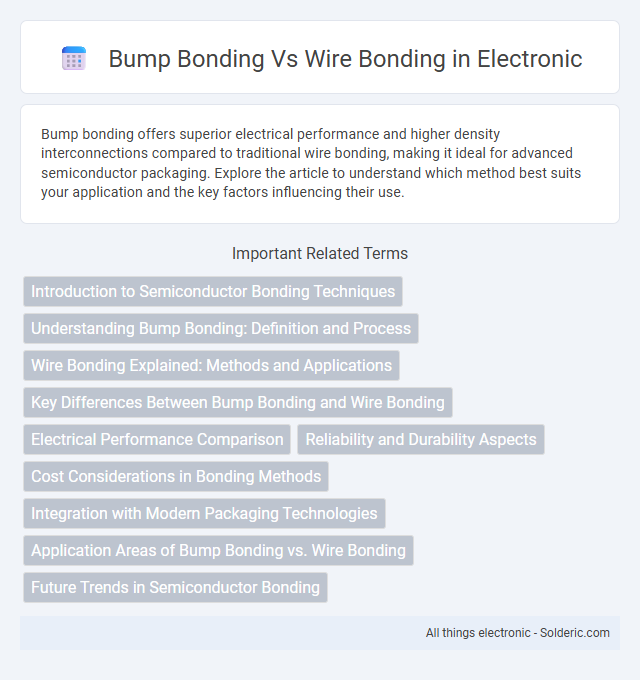Bump bonding offers superior electrical performance and higher density interconnections compared to traditional wire bonding, making it ideal for advanced semiconductor packaging. Explore the article to understand which method best suits your application and the key factors influencing their use.
Comparison Table
| Feature | Bump Bonding | Wire Bonding |
|---|---|---|
| Connection Type | Flip-chip bumps (solder, gold) | Fine metal wires (gold, aluminum) |
| Interconnect Density | High, suitable for fine pitch | Lower, limited by wire pitch |
| Electrical Performance | Lower inductance and resistance | Higher inductance and resistance |
| Assembly Complexity | More complex, requires precise alignment | Less complex, more mature process |
| Mechanical Strength | Strong mechanical bonds | Weaker, wires prone to damage |
| Application | High-performance ICs, 3D packaging | Standard IC packaging, prototypes |
| Cost | Higher initial cost | Lower cost, cost-effective |
| Thermal Performance | Better heat dissipation | Poorer thermal conduction |
Introduction to Semiconductor Bonding Techniques
Bump bonding and wire bonding are essential semiconductor bonding techniques used to connect integrated circuits to substrates. Bump bonding offers high-density interconnections with improved electrical performance and reduced parasitic inductance, making it ideal for advanced packaging like flip-chip technology. Wire bonding remains widely used due to its cost-effectiveness and reliability in attaching semiconductor chips to lead frames or printed circuit boards, helping you achieve efficient chip connectivity based on specific application needs.
Understanding Bump Bonding: Definition and Process
Bump bonding is an advanced semiconductor packaging technique that involves creating tiny solder bumps on the chip surface, which directly connect the integrated circuit to the substrate or another chip. This process enhances electrical performance and reduces signal interference by minimizing connection length. Understanding bump bonding helps you appreciate its advantages in high-density, high-speed electronic applications compared to traditional wire bonding methods.
Wire Bonding Explained: Methods and Applications
Wire bonding is a widely used technique in semiconductor packaging that connects integrated circuits to external leads using fine wires, commonly made of gold, aluminum, or copper. The two primary methods are ball bonding, which forms a ball-shaped connection using heat and ultrasonic energy, and wedge bonding, which creates a wedge-shaped bond suitable for aluminum wires and delicate surfaces. This method is favored for its cost-effectiveness, reliability in high-density interconnections, and versatility across various applications including microelectronics, sensors, and power devices.
Key Differences Between Bump Bonding and Wire Bonding
Bump bonding integrates micro-sized solder bumps for direct, high-density electrical connections, enabling shorter interconnects and better performance in advanced semiconductor packaging. Wire bonding uses fine wire loops to connect chip pads to package leads, offering flexibility and cost-effectiveness but with longer electrical paths. The crucial differences lie in connection density, electrical characteristics, mechanical strength, and suitability for high-frequency or miniaturized applications.
Electrical Performance Comparison
Bump bonding offers superior electrical performance compared to wire bonding due to its shorter interconnect paths, resulting in lower resistance and inductance. This technology enables higher frequency operation and improved signal integrity, making it ideal for advanced semiconductor applications. Your designs benefit from reduced parasitic effects and enhanced power efficiency when choosing bump bonding over wire bonding.
Reliability and Durability Aspects
Bump bonding offers superior reliability and durability compared to wire bonding due to its shorter electrical paths and robust mechanical connections, reducing signal loss and susceptibility to mechanical stress. Wire bonding, while widely used and cost-effective, faces challenges like wire breakage and susceptibility to thermal fatigue, impacting long-term performance. Consequently, bump bonding is preferred in high-reliability applications such as advanced semiconductor packaging and microsystem technologies.
Cost Considerations in Bonding Methods
Bump bonding offers a higher initial setup cost due to specialized equipment and precise alignment requirements, but enables greater miniaturization and higher yield rates for advanced semiconductor packaging. Wire bonding remains cost-effective for low to mid-volume production, benefiting from well-established, flexible processes with lower material expenses and simpler tooling. Choosing between bump bonding and wire bonding depends on balancing upfront investment against long-term performance gains and application-specific volume demands.
Integration with Modern Packaging Technologies
Bump bonding offers superior integration with advanced packaging technologies such as 3D ICs and system-in-package (SiP) designs due to its fine-pitch capabilities and high-density interconnections. Wire bonding, while cost-effective and reliable, is limited by larger pitch sizes and slower signal transmission, making it less ideal for compact, high-performance applications. Your choice between bump bonding and wire bonding should consider the specific requirements of modern packaging, including miniaturization, electrical performance, and manufacturing scalability.
Application Areas of Bump Bonding vs. Wire Bonding
Bump bonding is predominantly used in high-density electronic packaging applications such as 3D integrated circuits, flip-chip technology, and advanced semiconductor devices where space-saving and improved electrical performance are critical. Wire bonding remains the standard in traditional semiconductor packaging, particularly in low- to medium-density applications like microcontrollers, sensors, and power devices due to its cost-effectiveness and reliability. Industries such as consumer electronics, aerospace, and automotive leverage bump bonding for miniaturized, high-speed devices, while wire bonding continues to thrive in established markets requiring robust, well-understood interconnections.
Future Trends in Semiconductor Bonding
Future trends in semiconductor bonding emphasize increased adoption of bump bonding, driven by its superior electrical performance and higher density interconnect capabilities compared to traditional wire bonding. Advanced 3D packaging and heterogeneous integration are pushing the demand for finer pitch and more reliable connections, which bump bonding readily supports. Your designs will benefit from evolving materials like thermocompression and copper-to-copper bonding that enhance thermal management and signal integrity in next-generation electronic devices.
Bump Bonding vs Wire Bonding Infographic

 solderic.com
solderic.com